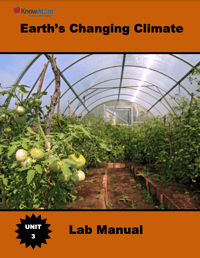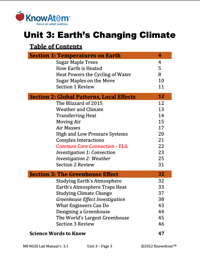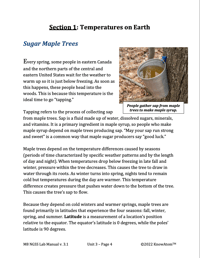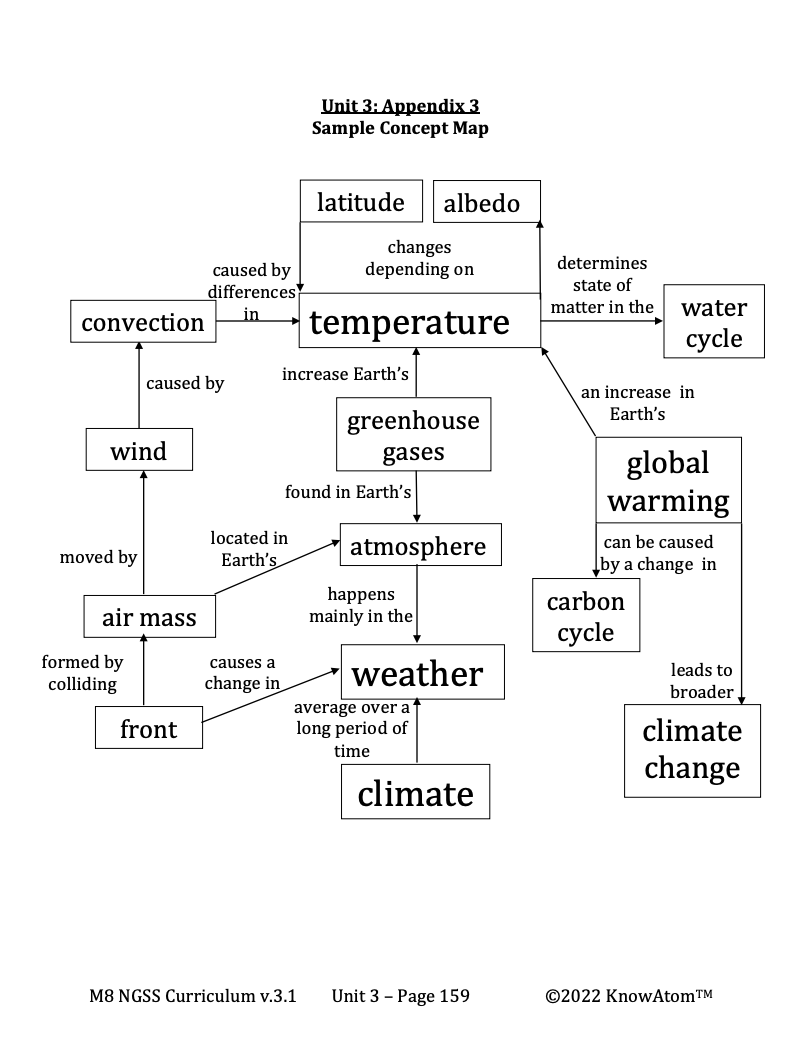Science background provides teachers with more in-depth information about the phenomena students explore in this unit on Earth’s changing climate. Below is an excerpt of the science background section.
How Earth is Warmed
Maple trees depend on the temperature differences caused by changing seasons (periods of time characterized by specific weather patterns and by the length of day and night). When temperatures drop below freezing in late fall and winter, pressure within the tree decreases. This causes the tree to draw in water through its roots. As winter turns into spring, nights tend to remain cold but temperatures during the day are warmer. This temperature difference creates pressure that pushes water down to the bottom of the tree. This causes the tree’s sap to flow, and people can collect the sap to make maple syrup.
Because they depend on cold winters and warmer springs, maple trees are found primarily in latitudes that experience the four seasons: fall, winter, spring, and summer. Latitude is a measurement of a location’s position relative to the equator. The equator’s latitude is 0 degrees, while the poles’ latitude is 90 degrees.
A location’s latitude plays an important role in its temperature. Temperature is a measure of heat. It is measured with a thermometer. This goes back to Earth’s position in the solar system relative to the sun. The sun is the primary source of energy on Earth. Its energy is transferred to Earth’s atmosphere and surface through radiation, which is heat transfer that occurs without contact between the heat source and the object heated.
But Earth’s surface isn’t heated evenly. Remember that the sun’s rays are the most concentrated around the equator. Moving north or south of the equator, the sun’s rays are spread over a larger area, so each square meter of Earth’s surface receives less solar energy. This is because of the angle of the sun’s rays as they strike Earth’s curved surface. Near the equator, the sun’s rays hit Earth at close to a 90-degree angle. This means that the sun’s radiant energy is concentrated within a small surface area. This results in warm temperatures. At higher latitudes, the sun’s rays hit Earth at a lower angle. This causes the sun’s energy to be spread over a larger surface area, which results in lower overall temperatures.
Seasons on Earth
However, latitude isn’t the only factor that influences temperature. As Earth orbits the sun, the amount of sunlight that reaches the planet changes over a year because of Earth’s tilt, which always points in the same direction, toward the North Star. As a result, the sun heats some parts of Earth more than others throughout the year.
When the North Pole is tilted away from the sun, it is winter in the northern hemisphere because the sun’s rays hit it at a lower angle. This decrease in temperature is what decreases pressure in maple sugar trees. At the same time, nights are longer and days are shorter. As Earth continues to orbit the sun throughout the year, the sun’s rays gradually hit the northern hemisphere at a higher angle because of Earth’s changed position in its orbit. This results in spring, longer days, and the beginning of sap flowing from the maple trees. This is why maple trees grow in temperate climates, where there are four seasons: summer, fall, winter, and spring.
Regions near the equator experience two seasons: the wet season and the dry season. Because the sun’s rays shine directly on the equator year-round, it never gets cold enough for winter. These regions also experience about 12 hours of day and 12 hours of night all year.
Regions near the North and South poles experience two seasons every year: winter and summer. When summer comes to the poles, there is daylight for almost 24 hours a day. In some locations, the sun never sets and it is light for a full 24 hours. This is called midnight sun. When winter comes to one of the poles, it is tilted away from the sun. As a result, this pole experiences “polar night,” when the sun never rises above the horizon.
The “Albedo” Effect
Another factor that contributes to Earth’s uneven heating is its varied surfaces, made up of forests, grasslands, oceans, polar ice caps, deserts, and cities. Each of these surfaces absorbs, reflects, and radiates energy from the sun differently. Earth's ability to reflect the sun's light, called albedo [al-bee-doh], is influenced by the color, type, and texture of various surfaces.
For example, glaciers act like mirrors, reflecting a large amount of energy from the sun back into space. This results in minimal heating of Earth’s surface and lower atmosphere, called the troposphere. As the glaciers melt, they become water. Water absorbs more heat than ice, which means that as the glaciers melt, Earth’s temperature becomes warmer because there is less ice to reflect the sun’s energy.
In contrast, dark-colored surfaces, such as oceans and forests, reflect very little solar energy. Picture the blacktop on a newly paved road on a hot summer day. Its dark color makes it a strong absorber, so little of the sun’s energy is reflected away. Instead, that energy is absorbed as thermal energy, which causes the road to become hotter.










